June 28, 2024
Air Date: June 28, 2024
FULL SHOW
SEGMENTS
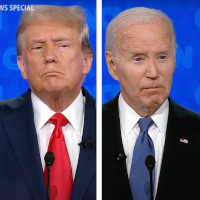
Presidential Debate and the Climate
/ Phil McKennaView the page for this story
At the first debate of the 2024 presidential election, President Joe Biden and former President Donald Trump gave vastly different responses to the single question on climate change. Inside Climate News Reporter Phil McKenna joins Hosts Aynsley O’Neill and Jenni Doering to discuss the highlights, what was left out of the debate, and what the two presidents have done on climate and environment in their times in office. (12:03)

Stay Safe in Summer Heat
View the page for this story
Heat waves can bring health problems and death for anyone but especially for the young, elderly, and people with conditions like heart disease and diabetes. And heat often coincides with other health-harming climate impacts like floods and wildfires. Dr. Ari Bernstein directs the National Center for Environmental Health and the Agency for Toxic Substances and Disease Registry at the CDC and joins Host Aynsley O’Neill to talk about the public health risks posed by heat and share tips for staying safe this summer. (13:04)
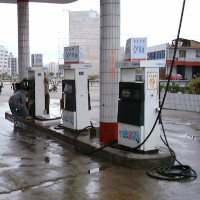
From the History Books
/ Peter DykstraView the page for this story
This week, Living on Earth Contributor Peter Dykstra and Host Aynsley O’Neill look back to the year 2000, when China finally banned the use of lead in gasoline. The same year, a historic rescue moved some 18,000 African or “jackass” penguins out of the path of an oil spill. (03:05)
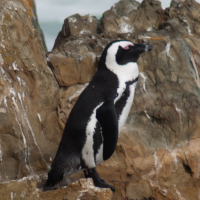
Listening on Earth: African Penguin Calls and Chicks
View the page for this story
In this short segment we hear why African penguins are sometimes nicknamed “jackass” penguins. Also, four chicks that recently hatched at the New England Aquarium are giving some hope to this threatened species. (01:11)
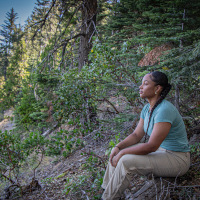
A Black-led Land Trust
View the page for this story
The 40 Acre Conservation League is an African-American grounded land trust that seeks to ease access to the outdoors for people of color, who have historically been excluded from green spaces. The nonprofit recently purchased its first piece of land, 650 acres bordering the Tahoe National Forest in northern California. Jade Stevens is the president of the 40 Acre Conservation League and joined Host Steve Curwood to discuss her vision for the land and improving access to nature for Black and Brown folks. (15:30)
Show Credits and Funders
Show Transcript
240628 Transcript
HOSTS: Jenni Doering, Aynsley O’Neill
GUESTS: Ari Bernstein, Jade Stevens
REPORTERS: Peter Dykstra, Phil McKenna
[THEME]
CURWOOD: From PRX – this is Living On Earth.
[THEME]
DOERING: I’m Jenni Doering.
O’NEILL: And I’m Aynsley O’Neill.
The danger of heat when it comes to health.
BERNSTEIN: Heat can be bad for many, many chronic health conditions, whether it’s diabetes or heart disease, even what we call neurodegenerative diseases like Parkinsons and Alzheimers. The more we look at it, the more we realize that heat is not unlike the proverbial straw on the camel’s back.
DOERING: Also, a new Black Land Trust purchases its first property.
STEVENS: Having the opportunity to just walk up and open the gate as if it was my house and opening the door and walking there for the first time, it, it kind of like made me breathless for a second, where I really held the key to allow the community to come onto this land with me.
DOERING: Plus - climate and environment in the first presidential debate of 2024. That and more, this week on Living on Earth—stick around!
[NEWSBREAK MUSIC: Boards Of Canada “Zoetrope” from “In A Beautiful Place Out In The Country” (Warp Records 2000)]
[THEME]
Presidential Debate and the Climate
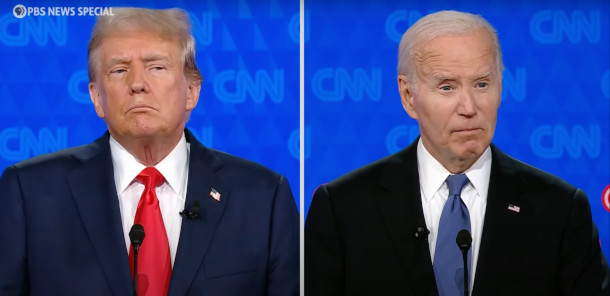
President Joe Biden and former President Donald Trump faced each other in a historic debate at CNN's studios in Atlanta. According to Nielsen data, a combined 47.9 million total viewers watched the CNN Presidential Debate on TV. (Photo: Screenshot of debate)
O’NEILL: From PRX and the Jennifer and Ted Stanley Studios at the University of Massachusetts, Boston this is Living on Earth. I’m Aynsley O’Neill.
DOERING: And I’m Jenni Doering.
On June 27th President Joe Biden and former President Donald Trump met on the debate stage in CNN’s studios in Atlanta.
Trump had a pretty slick demeanor but much of what he said was pretty far from the truth.
And Democrats have been agonizing over Biden’s poor performance, whether it be due to a lack of energy, his speech impediment, or a cold as his campaign says.
O’NEILL: And Jenni, I think it goes without saying that environment and climate were only minimally mentioned, but there was one climate question from moderator Dana Bash to former President Trump.
DANA BASH: Another persistent challenge is the climate crisis. 2023 was the hottest year in recorded history, and communities across the country are confronting the devastating effects of extreme heat, intensifying wildfires, stronger hurricanes and rising sea levels.
Former President Trump, you've vowed to end your opponent's climate initiatives, but will you take any action as President to slow the climate crisis?
TRUMP: Well, let me just go back to what he said about the police…
O’NEILL: But, as you can hear, he initially dodges the question.
DOERING: Yeah, that was a theme for former President Trump in this debate.
I stopped counting how many times he brought it back to blaming immigrants for crime and just about everything, and that’s where he eventually wound up in his answer after saying nothing about climate.
O’NEILL: So Dana Bash tried again.
BASH: 38 seconds left, President Trump, will you take any action as President to slow the climate crisis?
TRUMP: So I want absolutely immaculate clean water, and I want absolutely clean air. And we had it. We had H2O, we had the best numbers ever. And we did. We were using all forms of energy, all forms, everything. And yet, during my four years, I had the best environmental numbers ever, and my top environmental people gave me that statistic just before I walked on the stage, actually.
O’NEILL: Besides “clean air and clean water,” I would like a clear statistic. Jenni, what do you think he meant by “best environmental numbers ever”?
DOERING: Good question. If he’s referring to greenhouse gas emissions and air pollution levels, the COVID pandemic did clear up the air during the Trump presidency — because the world shut down.
Former President Trump claimed he had “the best environmental numbers ever” during this first term.
— Los Angeles Times (@latimes) June 28, 2024
That’s not true.
Read more from Climate Columnist @Sammy_Roth https://t.co/qqkv4N9oCH
O’NEILL: Right. And during his presidency Trump rolled back more than 100 environmental regulations, including many protecting clean air and water.
I also feel the need to mention that those issues aren’t at all the same as the climate crisis.
President Biden responded by touting the 2022 Inflation Reduction Act he signed, which invested around $370 billion in climate and energy programs.
BIDEN: I don't know where the hell he's been. The idea that anything he said is true. I passed the most extensive, most extensive climate change legislation in history, in history.
O’NEILL: And Biden went on...
BIDEN: We're in a situation where the idea that he is claiming to have done something to have the cleanest water? The cleanest water? He hadn’t done a damn thing for the environment. He pulled out of the Paris peace accord, climate accord. I immediately joined it, because if we reach 1.5 degrees Celsius at any moment, there's no way back. The only existential threat to humanity is climate change, and he didn't do a damn thing about it. He wants to undo all that I've done.
O’NEILL: You heard President Biden mention 1.5 degrees Celsius.
And of course that’s the goal set by the Paris agreement for the global temperature increase above pre-industrial levels that we’re looking to stay under in order to avoid disastrous tipping points.
DOERING: Disastrous is right, and by the way the latest US government figures say that in 2023, the global average temperature increase was already 1.36 degrees Celsius. You know, some experts say we’re even actually over 1.5 degrees.
But you didn’t hear former President Trump acknowledge the risks his opponent called “existential” for humanity.
TRUMP: The Paris Accord was going to cost us a trillion dollars, and China nothing, and Russia nothing, and India nothing. It was rip off of the United States, and I ended it because I didn't want to waste that money, because they treated us horribly. We were the only ones, it was costing us money. Nobody else was paying into it. And it was, it was a disaster.
BIDEN: The idea is that we, in fact -- We were the only ones of consequence, we’re not, we’re not members of the Paris Accord. How can we do anything if we’re not able to, the United States can't get its pollution under control? One of the largest polluters in the world, number one. We're making significant progress. By 2035 we will have cut pollution in half. We have made, we have made significant progress, and we’re continuing to make progress. We set up a Climate Corps for thousands of young people who’ll learn how to deal with climate, just like the Peace Corps, and we're going to, we're moving in directions that are going to significantly change the elements of cause of pollution. But the idea that he claims that he has the biggest heart up here and that he's really concerned about, about pollution and about climate, I've not seen any indication of that.

The U.S. Forest Service is amongst the federal programs collaborating with the American Climate Corps to train workers in wildfire regulation. (Photo: Gerrelaine Alcordo, Flickr, CC BY 2.0)
DOERING: Yeah, so Aynsley, I guess we got some talk about climate, but not that much for a 90 minute debate.
O’NEILL: Yeah, I had pessimistically predicted we wouldn’t have any discussion of environment and climate, and I really feel like I was almost right.
Not only was the single question half-taken up by other topics, but I think we nearly got more discussion over the candidates’ golf games.
DOERING: [LAUGHS] Oh yeah, um I think you’re right... Well, Inside Climate News reporter Phil McKenna was also listening in to the debate.
So Phil, I have to know -- what’s your handicap?
MCKENNA: [LAUGHS] Yeah, well, so I’m not much of a golfer but I certainly could carry my own bag.
DOERING: I’m sure you could.
MCKENNA: But yeah, you know, it’s disappointing to see the major candidates for the most powerful job in the world talk about golf when the world is on fire.
The US just sweltered under a heat wave that affected 110 million people, there are wildfires raging in California, and yet there was very little serious discussion in this debate on climate change, which truly is the existential threat of our time.
O’NEILL: Well, besides this debate what have these candidates been saying and doing about this existential issue?
MCKENNA: Well, whatever you make of Biden and his performance in this week’s debate, I can't think of a more stark difference on any issue between the two candidates than the issue of climate change in this election.
On the basic science, Trump has repeatedly called climate change a hoax created by the Chinese to hurt the US economy.
As for pulling the US out of the Paris Accord, even business leaders urged Trump to stay in the agreement.
Biden on the other hand has re-engaged the US in international climate talks.
DOERING: Oh yeah, by the way Phil, what was this thing we heard former President Trump say in this debate about the Paris Accord costing the U.S. trillions of dollars?
MCKENNA: Yeah, that’s not true, though under Biden, the U.S. has pledged $11.4 billion annually to assist vulnerable countries in developing clean energy and adapting to climate change.
And domestically, Biden passed the most significant climate legislation in US history, targeting hundreds of billions of dollars in tax credits towards clean energy, transportation, and building initiatives.
That was something he did briefly mention in the debate, but he missed an opportunity to really engage and highlight the jobs and economic growth that’s come from it.
O’NEILL: Yeah, for example electric vehicle jobs got no coverage at all in the debate.
MCKENNA: Right, those EV tax credits and incentives for manufacturing EVs in America that Biden had passed in the Inflation Reduction Act went unmentioned.
Trump, by the way, at one point in the debate obliquely referred to the Inflation Reduction Act as a “Green New Scam,” and he’s repeatedly said he’ll roll it back if elected to another term.
Now that would be difficult to do for two reasons. One, it was passed by Congress, so it can’t be easily undone. And two, a lot of red states, and states run by Trump’s supporters, are benefitting from billions of dollars of investments spurred by the IRA.
For example, Republican South Carolina Gov. Henry McMaster, is a big Trump supporter, but his state is also a leader in clean energy projects following the passage of the Inflation Reduction Act.
McMaster will not want those investments to go away.
DOERING: Now, President Biden has not been absolutely perfect on climate; I mean, like every other president, he has approved fossil fuel projects on federal lands, you know, after he promised to halt drilling. But Phil, how does that compare to his opponent?
MCKENNA: It’s really night and day. You know, early on in the debate, Trump had this phrase, “liquid gold under our feet” referring to fossil fuels, and throughout his first term he cozied up to the industry.
He opened up the Arctic National Wildlife Refuge to drilling, and tried unsuccessfully to bring back coal, while Biden just recently put a moratorium on new coal mining on federal lands in Wyoming’s Powder River Basin.
This is a region that produces more coal than any other in the country.
And Biden really has done a lot to boost clean energy like wind and solar, to help the nation transition away from fossil fuel use.
Trump, on the other hand, has spent a lot of time in speeches recently mocking wind energy and EVs.
And I was a little surprised Biden did not hold Trump’s feet to the fire about this dinner with oil and gas executives that Trump had back in April.
He reportedly asked them to spend a billion dollars on his campaign and in return he promised to lift a Biden Administration pause on approvals for new liquified natural gas export terminals, something the fossil fuel industry would love to see happen.
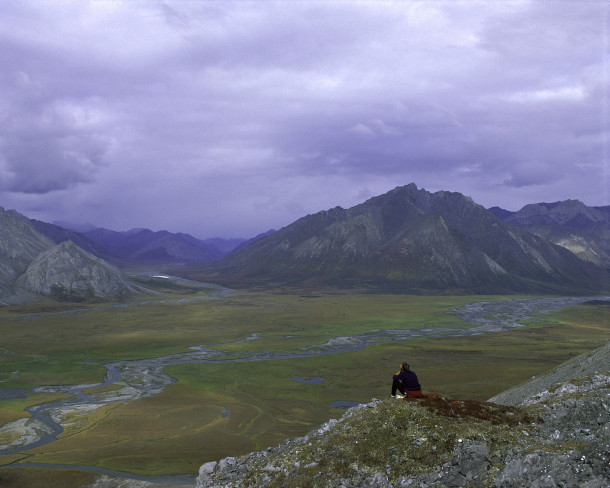
During his presidential term Mr. Trump issued drilling leases for 400,000 acres (160,000 hectares) of Alaska's Arctic National Wildlife Refuge (ANWR). President Joe Biden's administration has canceled oil and gas leases. (Photo: Steve Chase, USFWS, Flickr, CC 2.0)
O’NEILL: Phil, another environmental issue we completely skipped over in the debate was conservation and public lands. How do the candidates stack up there?
MCKENNA: Well, during his presidency Trump did sign the Great American Outdoors Act which fully funded the Land and Water Conservation Fund, although an executive order under his administration actually undercut it by giving state governors and local lawmakers the ability to veto federal land acquisitions made through that very same fund.
What’s more, he also slashed national monuments including Bears Ears, which Biden then restored.
DOERING: Now Phil, what about public and environmental health, there didn’t seem to be much there.
MCKENNA: Well, with just a couple minutes to go, Biden made a brief reference to getting lead out of water pipes, and in May his administration announced $3 billion for replacing all lead pipes nationwide within a decade.
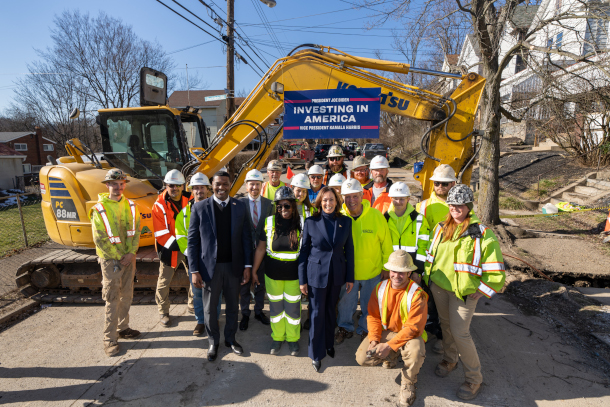
Vice President Kamala Harris, joined by EPA Administrator Michael Regan, poses for a photo with union workers who are removing lead pipes at an active construction site as part of the Biden-Harris Administration’s clean water investments, Tuesday, February 20, 2024, in Pittsburgh, Pennsylvania. (Photo: Lawrence Jackson, US Government, Flickr, Fair Use)
You heard former President Trump mention “clean air and clean water” but during his first term he rolled back regulations such as rules limiting mercury emissions from coal plants and methane from oil and gas drilling.
His administration also weakened rules on toxic discharges into waterways from coal ash and power plants.
Biden’s first term has been spent in part putting protections like those back in place.
DOERING: Hmm. So Phil, as we mentioned, a lot of the chatter about this debate isn’t about the actual substance of what the candidates said but it’s about their performance.
Democrats seem to be agonizing about President Biden’s shaky voice and talking about possible replacements — maybe Vice President Kamala Harris, or California Governor Gavin Newsom.
MCKENNA: Yes, President Biden has sent Vice President Harris out to make public appearances to drum up support for the climate initiatives in the Inflation Reduction Act.
And Governor Newsom has put his state on an ambitious path towards net zero carbon emissions by 2045.
But there are huge questions about how replacing the presumptive Democratic nominee this late in the election season would go.
O’NEILL. You’ve got that right. Thanks, Phil.
Phil McKenna is a reporter with our media partner Inside Climate News.
I’m sure we’ll talk soon.
MCKENNA: Thank you.
DOERING: Thanks Phil, thanks Aynsley!
Related links:
- Watch the 2024 Presidential Debate
- Scientific American | “Presidential Debate Contrasts Biden’s Energy Policy with Trump’s Climate Falsehoods”
- Atmos | “Fact-Checked: Trump and Biden’s Climate Claims at First Presidential Debate”
- EHN | “Climate Change Gets Short Shrift in Presidential Debate”
[MUSIC: Biréli Lagrène, “More” on Generation Django, Francis Dreyfus Music SARL, a BMG Company]
O’NEILL: The outcome of the 2024 US presidential election could profoundly shape the future of the climate and environment both at home and around the globe. And there are important down-ballot races and ballot measures too. Here at Living on Earth we are working hard to give you the stories and information you need to make your decisions on election day. So, what issues are you most interested in having us cover? Let us know by sending us a written or audio message at comments@loe.org. You can use the Voice Memos app on the iPhone, the Voice Recorder app on an Android device, or any similar app to record your message and then email it. And, we might just include your voice on air! Just be sure to give us a daytime phone number to reach you so we can verify your submission. So, email us, at comments@loe.org!
[MUSIC: Biréli Lagrène, “More” on Generation Django, Francis Dreyfus Music SARL, a BMG Company]
DOERING: Coming up after the break, how you can stay safe on hot summer days. Stay tuned to Living on Earth.
ANNOUNCER: Support for Living on Earth comes from Sailors for the Sea and Oceana. Helping boaters race clean, sail green and protect the seas they love. More information @sailorsforthesea.org.
[CUTAWAY MUSIC: Biréli Lagrène Gipsy Poject, “Place du Terte” on Generation Django, Francis Dreyfus Music SARL, a BMG Company]
Stay Safe in Summer Heat

Stay hydrated! Water and electrolyte drinks can help you fend off the heat. (Photo: Sue Thompson, Flickr, CC BY-ND 2.0)
DOERING: It’s Living on Earth, I’m Jenni Doering.
O’NEILL: And I’m Aynsley O’Neill.
This summer is gearing up to be one of the hottest, if not the hottest ever in recorded history. And with people already perishing in extreme heat, we all need to prepare ourselves and our communities for the scorching months and years ahead. Keeping us safe in this increasingly hot and dangerous world is one of the key concerns of Dr. Ari Bernstein. He’s the Director of the National Center for Environmental Health and the Agency for Toxic Substances and Disease Registry at the CDC. And he joins us now. Welcome back to Living on Earth, Dr. Bernstein!
BERNSTEIN: Great to be with you, Aynsley.
O'NEILL: Now, this recent heatwave has been affecting approximately 100 million people across 27 states. How would you link such an extreme event to climate change?
BERNSTEIN: Well, anyone who's been living in the same part of the country for a couple of decades will tell you, it's getting hotter. I mean, we've gotten to the point where warming is evidenced in communities around the country. One way to think about it is, there's always variation in temperature from year to year. We had an El Nino that made things particularly warm last summe, it's contributing probably a bit, although it's reversing now. But you can sort of think of a person dribbling a basketball, and the basketball going up and down as sort of the variability we see in weather from year to year. But we're now dribbling up an incline. And that's the warming of the planet as a whole. And so whatever lows, low temperature years on average we have are now at a higher baseline. And the higher temperatures as we can so clearly see, are beyond what anyone is used to in the places that people have been living for a while.
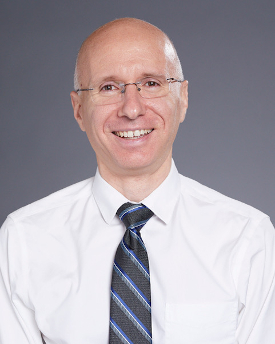
Aaron Bernstein, MD serves as Director of the National Center for Environmental Health and the Agency for Toxic Substances and Disease Registry at the Centers for Disease Control and Prevention. (Photo: Courtesy of Harvard T H Chan School for Public Health)
O'NEILL: And could you delve into the effects of these record-breaking high temperatures both for the individual person but also for our communities?
BERNSTEIN: Heat can be radically misunderstood in terms of what it means to people, let alone everything in the world around us. In medical school, when I was taught about heat, it was about so-called heat related illness, which is not sort of anything bad that can happen to health when it gets hot out, it really refers to very specific clinical problems like heatstroke. The evidence is clear though that when it comes to health, heat can be bad for a lot of things. Many, many chronic health conditions, whether it's diabetes, or heart disease, even what we call neurodegenerative disorders, like Parkinson's and Alzheimer's. But the effects of heat on health go way beyond that. So we know that heat affects, for example, learning in childhood, it really can affect how people do on tests. And in some cases, when you're taking like a high stakes test, whether that's the SATs or the Regents exam, the implications of not doing well on those tests is a big deal. Heat can affect how safe it is to work outside and how productive workers can be. We even see effects on people working indoors, and especially in places that may not be adequately air conditioning in terms of injuries, but also mistakes that people might make while working. And the more we look at it, the more we realize heat is not unlike the proverbial straw on the camel's back. So you take an existing challenge we face, whether it's health or economic, and too much heat makes it harder to get over that. And so we're at CDC really focused on trying to prevent what are entirely preventable harms from heat to health. We're really focused on communities and individuals who we know are most at risk. Those are people who have significant chronic medical problems, don't have access to air conditioning, or can't afford it, and people who are socially isolated, among many other factors that we know really can up the risk of heat to health.
#DYK? Temperatures inside a car can rise almost 20°F in only 10 minutes, even with a window cracked open.
— CDC Environment (@CDCEnvironment) June 27, 2024
NEVER leave children or pets in a parked car. Children left alone in parked cars are at greatest risk for heat stroke. https://t.co/otLw4rPvnG #HeatSafety #BeatTheHeat pic.twitter.com/Y6c6qPQshN
O'NEILL: Well, let's talk for a moment about these vulnerable populations: the very old, the very young, the unhoused, the isolated. How does the CDC address this discrepancy?
BERNSTEIN: So our job at CDC is to protect health and improve lives. So we have for many years supported programs in states. And I would say that the best innovations we have in this country around getting to those most at risk communities are happening at the local level, because the pathways to safety, as I like to call them, around heat are really locally best defined. And so we've seen whether that's in Maricopa County, where there's a tremendous challenge with just the extraordinary temperatures, you know, it was over 110 for over a month in Phoenix last year. And they are working tirelessly to figure out how to deal with that challenge to people who lack housing, who have substance use disorders in particular. So one of our primary responsibilities is how can we best spur innovation and support the activities at local levels that are really focused on that. We also released on Earth Day this year, the first of its kind health-based heat forecast. This is transformative because up until now, the heads up we got about heat were the National Weather Service's heat alerts and heat warnings. Those were based on percentiles of temperature in specific parts of the country, but they weren't tied to health outcomes. They also tended to be given relatively close to when the heat event started so maybe two three days. The new tool which we call heat risk, is able to give a seven day forecast that is health based, meaning when you go up in increment on the scale and there are four levels there's green, yellow, orange, magenta. As you go up one level in that, it specifically means in that county, that there has been observed increase in health effects from that increment. So it does two things right away. One is it gives you more lead time, right. So you now have got more time to think ahead and plan. And the second is, it enables individuals and communities to really think carefully about, you know, hey, many folks in our community are going to be totally fine on a yellow day. You know, it's nice to know that it might be hotter than usual that there is some actual health effect here, but most people are okay. There may be some people who are not though. And we can start sort of targeting interventions in those at-risk communities on those days. So too, with orange. Pretty much everybody's going to start having trouble with too much heat exposure on a red day and magenta days, as we saw in this country, in the past weeks, are really dangerous for pretty much everybody. And so that incremental piece is critical, because we also know from evidence that the heat alerts that are given by the National Weather Service are given at temperatures well above those that we know, a large share of those people most at risk are already getting sick below those temperatures. So I think the heat risk tool, which you can find at cdc.gov/heat risk is a huge step forward to enabling the interventions that I mentioned at the local level, that are really innovating ways to find pathways to safety.

Philadelphia residents seeking refuge in the shade of Rittenhouse Square Park on a hot June day. (Photo: Shanzay Asif)
O’NEILL: And what are sort of the individual steps that someone should take when it comes to dealing with the heat? Is it simply hoping you can find a nice air conditioned space and a cool glass of lemonade? What does someone do in that situation?
BERNSTEIN: So we have a mantra: “Stay cool, Stay hydrated, Know the symptoms.” So staying cool could mean anything from using a fan, and fans can be remarkably effective. We know that if things are getting super hot, they can be counterproductive. We generally suggest that fan use is helpful well into the 90s. But you know above that you can run into situations where heat, you know, like a convection oven, the fan can actually increase heat absorption into the body. But fans are really good, shady spots and parks can be immensely cooler. And of course, even going, if you're in a multi story building down a few levels, you know, to a neighbor's place can be cooler too. Then, of course, there's air conditioning with the main challenge being it's expensive. And during these recent heat waves, we had power outages. And so relying solely on air conditioning, again, thinking about the folks who have the hardest challenge in accessing air conditioning, we obviously need it. But we need to think about the layers of protection we can put in before we are wholly reliant on air conditioning. And unfortunately, there are more and more days when you need AC. So that's the “Stay cool” piece. And in our work, we're really focused on what works for that individual. That could be AC, it could be that shady place in a park, and whatever is going to be accessible and effective. Stay hydrated. Drink water, first and foremost. There are a lot of beverages that people tend to pound that may not be so helpful, caffeinated beverages, sugar sweetened beverages, alcohol may all promote dehydration. So we tend to advise going for water. People with kidney disease or heart disease may need to be more careful because their bodies are more fluid sensitive. And that's really important for them to discuss with their providers, which again is a key part of our guidance that we have given that ties into heat risk. So we have specific guidance for people with, for example, cardiovascular disease, that tries to get people to have proactive conversations with providers saying "Hey, it's super hot out. What should I be thinking about with hydration?" We know that our bodies can tell us when we're well hydrated. Our mouths are wet inside, our urine is clear, if not maybe a little bit yellow. If it gets dark yellow, it’s, body's telling us we're not as well hydrated. And then know the symptoms is critical as a sort of third piece of the mantra because if you think you're staying cool, and you're trying to stay hydrated, but your body's telling you things, you need to listen. And depending upon who you are, those may appear differently. For people with chronic conditions like diabetes, when you get dehydrated or overheated, your blood sugar's not going to be well controlled, it’s gonna be harder to control. People with heart disease may start to experience the symptoms of their heart disease. And though those are symptoms for certain diseases, a lot of people independent of that who are otherwise healthy, they may feel nauseous, they may get headaches, their skin may get really warm, red, may start having a lot of sweat or even no sweat. There are common symptoms of your body getting overheated. And those are important because that's when you need to take a step back and saying, if possible, and one of the things we clearly recognize is that not everyone can get themselves to safety with heat. But to the extent possible, that's time you need to try and take a break, go someplace cool off, even for an hour or two can make a huge difference in terms of risk. And so knowing the symptoms is really a critical third part of that mantra.
We're excited to announce the new group of communities that will be part of the NIHHIS-CAPA Urban Heat Island mapping campaign program! To learn more about what the communities will be doing this summer, see the NOAA press release: https://t.co/TqZ0Z2HWrk #UrbanHeatMaps2024 pic.twitter.com/9e3VOylyop
— National Integrated Heat Health Information System (@HeatGov) April 16, 2024
O’NEILL: Well, climate change linked extreme heat is only going to get more intense in coming decades. And on top of high temperatures, there's also ties to other climate disruption, like forest fires or deteriorating air quality, flooding even in some parts of the United States. So how do you sort of approach a full perspective on that?
BERNSTEIN: We are aware of concurrent health challenges from extreme events like heat, and fires or heat and floods. We've already seen heat and floods in Florida this year. Last summer, we had heat and wildfire smoke across huge parts of the country. So we see the reality that is these events are happening at the same time. And our guidance is picking up on that. So if you go to our dashboard on heat, cdc.gov/heat risk, on the front page, we have the heat risk forecast, we also have the air quality index, because many of the low cost easy wins around heat, whether that's opening windows, or other measures may not be the best choice if there is a lot of air pollution. Especially for conditions that are really sensitive to that, like asthma or heart disease. So we are moving into an integrated approach to these risks. And we have already a tremendous amount of resources around flooding. And we're integrating that with heat because we see these things concurrently. And the recommendations may be different. In flooding situations, one of the two most common challenges are no power and no water. Well, the traditional heat response requires air conditioning and cooling off by taking a cool shower. Well, if you don't have water, and you don't have electricity, those two things may be hard to do. And so we need to think differently about how to keep people cool in the event that you're dealing with flood and heat concurrently is one example. And similar considerations for heat and wildfire smoke, which is another relatively common concurrent event. And so we're really focused on working again with communities around the country to figure out how we can do better in preventing what is wholly preventable harm from heat. I am certainly committed to that in our work at CDC and I know our partners in states around the country are as well.
Warm temperatures can quickly rise to dangerous levels — especially in the summer and in parked cars. Stay #WeatherReady and don’t underestimate the heat. https://t.co/Ynl3VCdFFD pic.twitter.com/3IniJJiiGV
— National Weather Service (@NWS) June 27, 2024
O'NEILL: Dr. Ari Bernstein is the director of CDC's National Center for Environmental Health, and the Agency for Toxic Substances and Disease Registry. Dr. Bernstein, thank you so much for taking the time with me today.
BERNSTEIN: Great to be with you.
Related links:
- The CDC’s HeatRisk tool
- The CDC’s Heat and Health Index
- CDC’s heat guidance can be found here
[MUSIC: João Mastrodomênico alto sax, “Summertime” on João Mastrodomênico’s online subscription site or Youtube by George Gershwin]
From the History Books
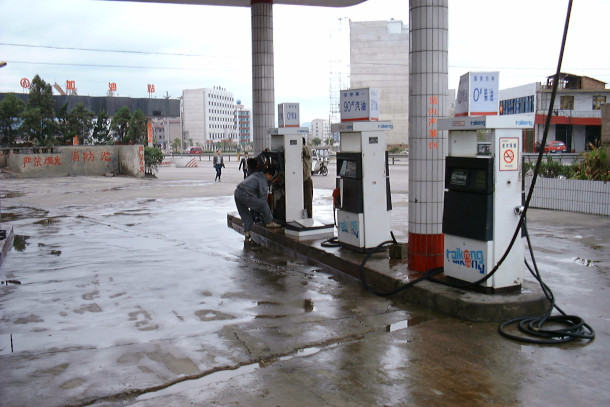
The sale of leaded gasoline in China was banned in July 2000. (Photo: LHOON, Flickr, CC BY-SA 2.0)
O'NEILL: On the line with me now from Atlanta, Georgia is Peter Dykstra. He's gonna take a look through the history books for us today. Hey, Peter, what do you have?
DYKSTRA: Hi Aynsley, the first piece is from good news from a very big and important place. It goes back almost a quarter of a century. On July 1, 2000, China banned the manufacture and use of leaded gasoline. Evidence from around the world showed the linking of burning of leaded gasoline caused brain damage and declining IQ levels, particularly in children. Childhood lead pollution is still a problem in China. So it's hard to gauge exactly how much this leaded fuel ban has helped, because there are so many other industrial sites in China that still use lead. But either way, it's good news that they've been off leaded gasoline for 24 years.
O'NEILL: And in the US, I think we started a ban on leaded gasoline in the 70s or so right, Peter?
DYKSTRA: Yes, we did. But there are still some uses here and there for leaded gasoline in the United States, still perfectly legal. One is general aviation, small propeller-driven planes can use leaded fuel, and some lawn equipment can also use leaded fuel, but for the most part, it's been gone. And the beneficial health impacts show very strongly here.
O'NEILL: Yeah, it's a boon for you know, a young person's health and development. And Peter, what else do you have for us this week?
DYKSTRA: Also, from the year 2000, how can you not love a species called the Jackass penguin? There were 18,000 Jackass penguins that were in danger from an oil slick along with other wildlife that were airlifted out of the path of a slick from a sunken Panamanian tanker. This near the South African city of Cape Town. The South African National Foundation for the Conservation of Coastal Birds organized the rescue and it successfully moved Jackass penguins also known by the somewhat more polite name of African penguins out of harm's way from the slick.
O'NEILL: I love those penguins, Peter. I get to see them all the time at the New England Aquarium, but never 18,000 at once. That's quite the rescue.
DYKSTRA: That'd be a problem for an aquarium. But one other thing that one of the sites of this rescue is famous for: Robben Island right near Cape Town took the brunt of some of the spill. If you've heard of Robben Island before,it's probably because it's also home to the infamous prison where Nelson Mandela was held for so many years.
O'NEILL: Peter, I've got to hand it to you, only you can somehow get a fact about a Jackass penguin and a fact about Nelson Mandela into the same sentence.
DYKSTRA: And only on Living on Earth.
O'NEILL: Alright, thank you, Peter. I appreciate you bringing these stories from the history books, and we will talk to you again soon. Peter Dykstra is a contributor to Living on Earth.
DYKSTRA: Thanks, Aynsley, we'll talk to you soon.
O'NEILL: And there's more on these stories at the Living On Earth website, loe.org.
Related links:
- Read more about China's phase out of leaded gasoline
- BBC On This Day | "2000: Record-Breaking Penguin Rescue"
[BRAYING SFX]
Listening on Earth: African Penguin Calls and Chicks
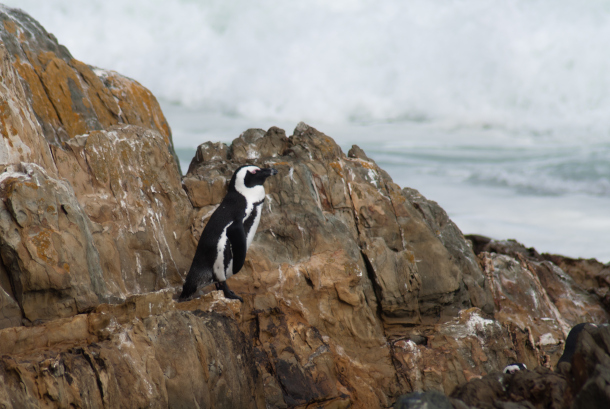
African penguins live on the coasts of South Africa and Namibia. (Photo: Megan Trace, Flickr, CC BY-NC 2.0)
DOERING: By the way, those African penguins or Jackass penguins as they are sometimes known really do make a racket!
[BRAYING SFX]
DOERING: Hence the nickname, since they sound almost like a braying donkey or “jackass.”
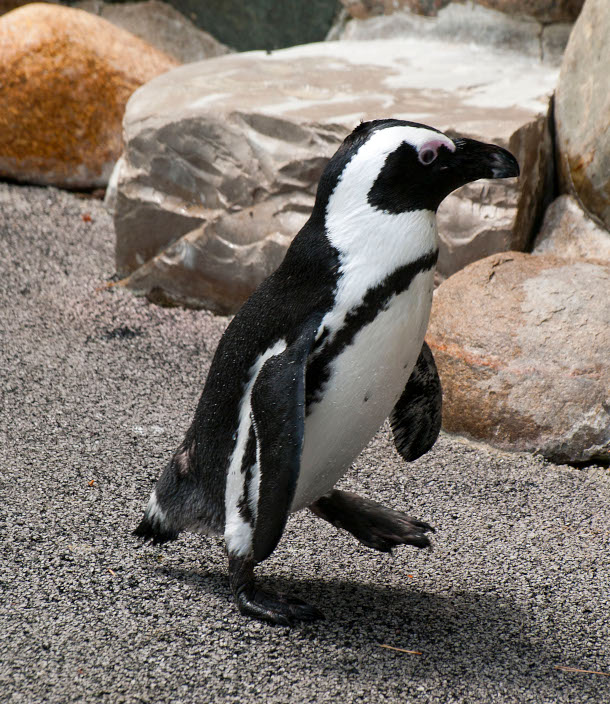
African penguins are also known as “Jackass” penguins, a reference to their loud, donkey-like “bray.” (Photo: David Ellis, Flickr, CC BY-NC-ND 2.0)
[BRAYING SFX]
DOERING: They’re from the coasts of South Africa and Namibia and like many birds are threatened by climate change and overfishing.
[PENGUIN CALL]
DOERING: So, breeding programs at zoos and aquariums are helping boost their numbers. In fact, four chicks hatched at the New England Aquarium this spring and have been cared for by staff behind the scenes. Two of them, named Bunker and Althea, recently joined the African penguin colony out on display.
[BRAYING SFX]

African penguin chicks gather in the wild. Breeding programs at zoos and aquariums are helping maintain the species’ endangered population. (Photo: steve micnicholas, Flickr, CC BY-NC-ND 2.0)
DOERING: The other two hatched a little later but should be named and out on exhibit soon. These little fluffs really are adorable and you’ll just have to visit the Living on Earth website at loe.org to see photos.
Related links:
- Listen to more Jackass Penguin calls!
- Check out the New England Aquarium’s brand-new penguin chicks!
O’NEILL: Coming up, a Black-led land trust is connecting people of color with the mountains of California. That’s just ahead on Living on Earth.
ANNOUNCER: Support for Living on Earth comes from Friends of Smeagull the Seagull and Smeagull’s Guide to Wildlife. It’s all about the wildlife right next door to you! That’s Smeagull, S - M - E - A - G - U - L - L, SmeagullGuide.org.
[CUTAWAY MUSIC: Richard Freeman, “Autumn Blues” on Luna, Relax Café Music]
A Black-led Land Trust
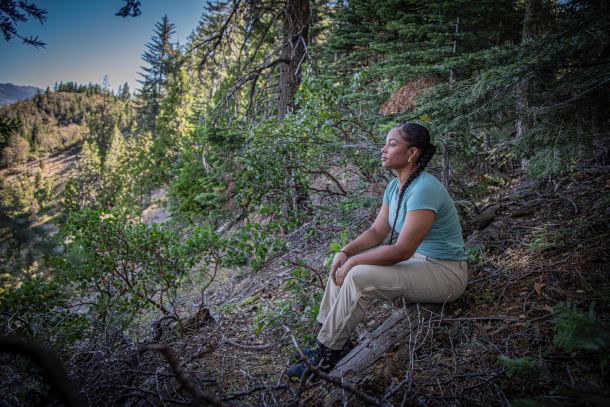
Jade Stevens says she wants to create a space where people of color feel safe and welcome so they can enjoy the outdoors. (Photo: K2J Productions)
O’NEILL: It’s Living on Earth, I’m Aynsley O’Neill.
DOERING: And I’m Jenni Doering.
Green spaces tend to be harder to come by in communities of color, one of the many consequences of redlining, the racist practice of denying mortgages to Black families. And Black and Brown people often feel unsafe and unwelcome in wilderness and park areas dominated by white recreators. In a 2020 incident that went viral, a white woman called the police on a Black man who was birding in Central Park in New York City, sparking awareness about racism in outdoor spaces. Now, the first Black Land Trust in California, the 40 Acre Conservation League, is trying to right these wrongs. With $3 million in funding from the state Wildlife Conservation Board and Sierra Nevada Conservancy, the nonprofit recently purchased its first piece of land, 650 acres bordering the Tahoe National Forest in northern California. Jade Stevens is the President of the 40 Acre Conservation League, and she joined Living on Earth Host Steve Curwood.
CURWOOD: So before we talk about the project, let's talk a little bit about you and your own experiences. Tell me something that inspired you to start the 40 Acre Conservation League.
STEVENS: You know, I've always been in love with the outdoors. I have really great experiences as young as, I don't know, middle school, or even elementary school, as a Girl Scout, where I was able to do camping trips with my friends, hanging out on the beach, learning how to surf. And fast forward to now as an adult, my experience, similar to many, around 2020, during the pandemic, I found new activities to get me outside and just clear my head. And that was really cycling. And so being able to ride around some of the familiar trails and routes throughout California, I rode along PCH all the way to San Diego, I've gone up north to Santa Barbara and even rode around Northern California. And I realized that I didn't really see a lot of Black women like me cycling, and thought that if people were to join me and to see what I saw, they would really enjoy being outside. And so this ongoing love that I've had for the outdoors has been something that I've wanted to share with others. And so that is one of the things that really led me to starting the 40 Acre Conservation League.
CURWOOD: So talk to me about your experience and your concern as a Black woman about what it's like to be outdoors and how other Black people, other Black women, other people of color, have some trepidation about being outdoors.
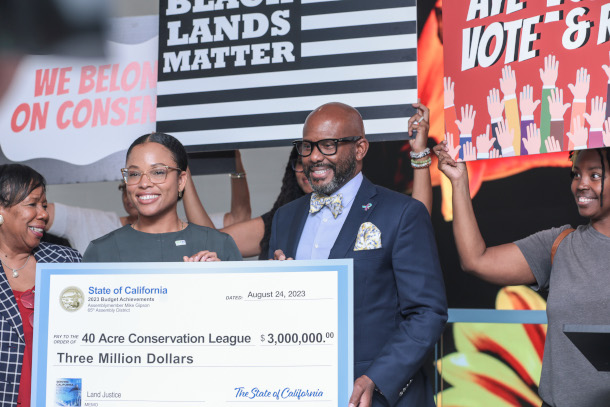
The 40 Acre Conservation League received $3 million in funding from California’s Wildlife Conservation Board and Sierra Nevada Conservancy to purchase their first property. Here, 40 Acre Conservation League president Jade Stevens (center left) and Assemblymember for California’s 65th Assembly District Mike Gipson (center right) pose with the ceremonial check. (Photo: K2J Productions)
STEVENS: Yeah, as much as I love cycling, and where it's taken me, I've definitely ended up in areas where I didn't feel exactly welcomed or safe. And one thing as a cyclist that we all have to remember is when you're on your bike, you're really on your own, right? You have your phone to call someone, but there are certain areas where there just isn't a strong connection. And so I've definitely been in areas within the mountain where there was really no one there but me and you know, thinking about who can I call on who would you know, be willing to open their door, right, if I were to end up in a flat or if I actually injured myself. And I do remember a personal experience riding through the Trump caravans and being blocked off from getting through the road because they didn't want us throwing off their rally, right? I will say that I definitely felt uncomfortable, just kind of hearing people say like, we don't want you here, or get out of the way. I think that was a wake up call for me. And so those are experiences that could have turned out more dangerous, but it only takes one story, one experience to really deter others from wanting to try those things out. And I encourage people to be aware of those things. But I hope that through the work that we're doing, they'll still feel comfortable to do it together with people that look like them.
CURWOOD: Let's talk a little bit about the history behind the name that you've picked, the 40 Acre Conservation League. Of course, famously, during the Civil War, General Sherman as he was marching through had many Black people attached to his column, because if you joined up with the Union Army, you were free if you were a slave. And finally, I think he turned around and said, look, you don't have to stick with me, we'll get you 40 acres and a mule. Of course, as we know, that never really happened for most, or certainly a whole lot of Black people. How does General Sherman's promise, the failure to meet that promise, connect with your organization's present mission?

The 650-acre property borders Tahoe National Forest and is home to plenty of wildlife. (Photo: KJ2 Productions)
STEVENS: Right, yeah, 40 Acre Conservation League was inspired by that unfulfilled promise of 40 acres and a mule. And, you know, the damage from that moment, right, has been equivalent to almost $326 billion in Black land loss. From that moment of an unfulfilled promise of getting land, the Black community has really suffered from that. And so rather than dwell on something that was promised to us, the idea of the 40 Acre Conservation League was really meant to inspire a new way of thinking about it. And so we know that land ownership is one of the key factors that really pushes generational wealth. And so with that, we thought, if we were able to acquire land, and really remove that as being a, you know, true barrier from achieving economic success, we would want to do that, to really help think about how we can change that outcome of the unfulfilled promise. And we're really focused on finding ways to use this as a catalyst to get more people into the conservation space and really the outdoor industry and really tap into the opportunities that lay there.
CURWOOD: And now you've purchased your first piece of land in California with funding from organizations like the Wildlife Conservation Board, the Sierra Nevada Conservancy. So for a moment, take me with your words to this land. Where is it exactly and what does it look like?
STEVENS: Right, so this land is located in an area called Emigrant Gap. It is the midway point between Sacramento and Lake Tahoe. And the first thing you would see when you get to the property is Lake Putt. It is a 30 acre lake that is beautiful and is really one of my favorite places to kind of sit down and reflect. Outside of the lake, there is miles of trails that you can walk and explore around the different mountainscapes and trees. And if you're feeling like taking a hike, there's a creek that you can follow from the lake that goes for a couple more miles deeper into the property. If you're familiar with Lake Tahoe, and the Tahoe National Forest, that is one of the major borders around our property. And it's really just a beautiful place.
CURWOOD: But I mean, I have to ask you this. I mean, that territory tends to have mountain lions as well. I mean, how safe is it to hike in there?
STEVENS: No, you're right. There's definitely mountain lions there. I remember the first time I went there, I did see a couple of footprints from what I'm sure were mountain lions. But in addition to that, there are deer, bumblebees, butterflies. So I mean, yes, you are in their home. And I understand that that might be a little concerning for those that are just dying to visit the property. But I do think with proper education and just increasing everyone's eco literacy, they'll have a better understanding on how we can both enjoy the property without any sense of risk.
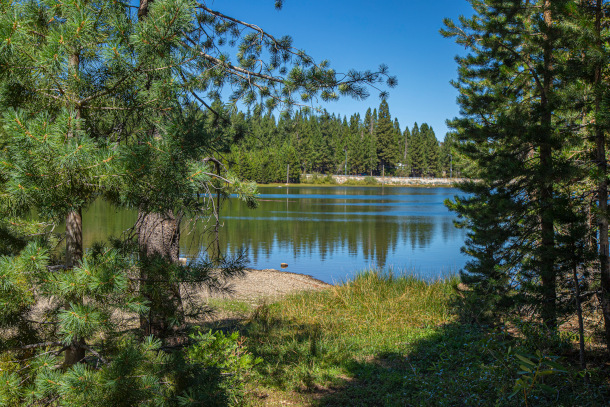
The property includes 30-acre Lake Putt, along with miles of mountainscapes and forests. (Photo: K2J Productions)
CURWOOD: So what's your vision for this land moving forward, Jade? How do you plan to bring the 40 Acre Conservation League's mission to life there, next to the Tahoe National Forest?
STEVENS: Right, so the work that we do, our mission and vision is to achieve an outdoor for all, where everyone can feel safe and welcomed to nature. And we see this happening in three ways, which is really the pillar of our work: through economic justice, environmental justice, and recreational justice. So starting with recreational justice, this is really something that we believe is possible for everyone. We want people to be able to enjoy the outdoors in a way that is accommodating and safe and publicly accessible to everyone. If we can achieve that, then we're increasing the connection and appreciation for the outdoors, which helps us to achieve the second pillar, which is environmental justice, helping people understand the importance of conserving land and why it's so important to protect this. And then once people appreciate how important it is to enjoy it, for those that have entrepreneurial views, that helps us hit our third pillar, which is economic justice. That outdoor economy is $97 billion. But it is not diverse. The number of registered foresters, ecologists, scientists is less than 1% across the board when we're talking about people of color, and so being able to not only enjoy it, and understand how to protect it, but finding a way to really benefit from it as an entrepreneur is something that we believe can all exist in the conservation space. And that is the vision that we have with all of the land we acquire.
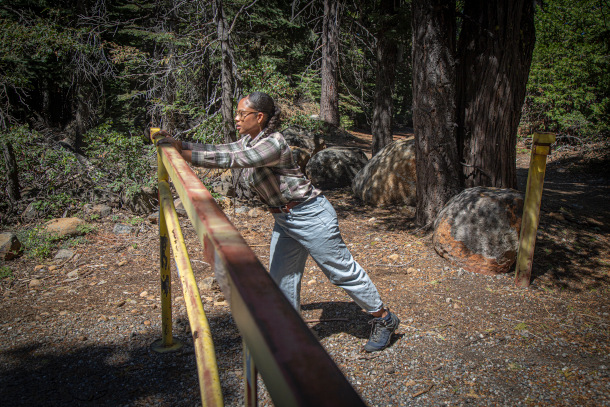
Jade Stevens pushes open the gate of the new property. (Photo: K2J Productions)
CURWOOD: So the richness of the land, from the land, and what about for the land? How do you plan to make sure that the ecology of this place stays intact, it doesn't perhaps get loved to death, which can happen in some public spaces?
STEVENS: Right, yeah, I think we rely not only on the work that we're doing right now with the land, but relying on our partners to increase eco literacy and have more educational programming for the everyday person to understand what it means to conserve land. And so 650 Acres is a huge space, and there will be certain areas that people will be able to recreate at, but most of it will be left untouched, right? There's a balance between having areas that are designated for camping, fishing, hiking, while also having other areas that are protected based on the habitat that's there.
CURWOOD: California is a risky place for wildfires. How do you plan to deal with that threat in the coming years and decades as climate change continues to get worse? It's getting hotter and hotter.
STEVENS: Yes, climate change is something that we are actively following. When we chose this land, we knew that it was in a wildfire risk zone and those across the country know California is synonymously associated with wildfires. And so we received funding to do two things: one, which is public access planning, and the larger part is forest health and restoration. And that is a huge part that can help us respond to wildfire risks. And so our job now is to identify areas that have an overgrowth of shrub or an overgrowth of fuel that could really give way to a spread of wildfire and clearing that out. So that work is already underway. It's something that will be continuous, where we are identifying sections within the property that needs to be restored and removed. And that's something that we're constantly seeking funding for to continue the work to do our part in reducing the chances of wildfire in that area.
CURWOOD: So what do you hear from people of color about your project and how they experience the outdoors? How crucial do they see a space like this being?

Jade says the property will provide some spaces where people can recreate, while other areas will remain untouched for conservation. (Photo: K2J Productions)
STEVENS: You know, you just took me back to a letter that we received when we announced the acquisition of our first land. And it came from an inmate at San Quentin prison. And he wrote us a letter after watching a news segment that we acquired this land. And I'm not gonna lie, I got a little emotional, because I was not expecting that. But his letter was just filled with gratitude that he was inspired, even though that he was in a cell, that he was inspired, that when he would be released, that he would have a place to go to. Growing up in LA, seeing people that have never, you know, left their block, he now is looking forward to the opportunity to go to a place that he feels welcome. And so there's so many opinions, and I've said them myself, you know, not feeling comfortable, are there mountain lions there, but then on the other side, we're hearing such great feedback from more people saying that, because we saw you there, I can't wait to go on the first tour. And so that's really inspiring and motivating for us that being able to just plant the idea into the community that you know, we belong, is something that we want to continue and really start a movement.
CURWOOD: So Jade, this is just your first piece of land that you have helped acquire for the public of color. What are you hoping the 40 Acre Conservation League will accomplish in the next, I don't know, 10, 20, 30, 40, 100 years?
STEVENS: Our goal after this first land acquisition is to continue to acquire more land in different terrains. We have a formula that really guides the property we go after. And because we are really trying to connect the community to the outdoors, we tend to look for land that is between 100 or 150 miles away from an urban area. So Sacramento is a good example, Emigrant Gap is about 70 miles from the city. And so we are actively looking for other land opportunities in the Bay area, near Los Angeles, near San Diego. And since you said 10, 20, 30 years, eventually across the country, and knowing that different terrains, from the forest to the beach, even to the desert, are different experiences that people are ready to explore. And so that is something that we hope to continue doing, as we continue on this work.
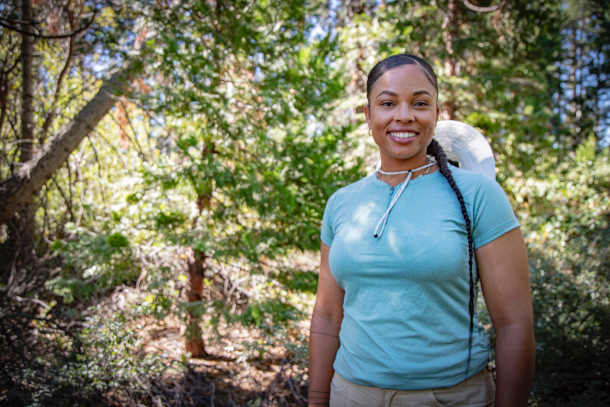
Jade Stevens is the president of the 40 Acre Conservation League. (Photo: K2J Productions)
CURWOOD: Jade, take me back to the moment when you realized that you wanted to have open space for people of color, and that you were the one that could somehow make that, or at least help make that happen?
STEVENS: Right. Again, you're taking me back to these great memories when I got the key to the gate that opens for the property. And we had many moments, from the board approving us for the funding and having visited the land already from the previous owners, but having the opportunity to just walk up and open the gate as if it was my house and opening the door and walking there for the first time, it kind of like made me breathless for a second, where I really held the key to allow the community to come onto this land with me. And so it was so memorable, but also really symbolized exactly what you said, that I now have the responsibility to really do my part in building this connection with nature and really improving the relationship for people of color with nature. And so it's something that I don't take lightly. It's something that makes me excited because I personally love the outdoors. And I just can't wait to share this with everyone.
DOERING: That’s Jade Stevens, President of the 40 Acre Conservation League, speaking with Living on Earth Host Steve Curwood.
Related links:
- 40 Acre Conservation League
- Wildlife Conservation Board
- Sierra Nevada Conservancy
[MUSIC: Richard Freeman, “Good Vibes” on Good Vibes, Relax Café Music]
O’NEILL: Next week on Living on Earth,
How the cosmos profoundly shapes our understanding of science and marks special moments in our lives.
TROTTA: Many, many years ago, on a dark night, in my native Switzerland, which is a landlocked country which at that time still enjoyed some quite dark skies, I had a date and my date and I were out for an evening at the theater, and then we were walking back home, and then we both happened to look up at the sky at a very special moment, where something really special and magical happened. It was a meteor passing by, a shooting star, if you like. Which appeared to be, the perfect romantic moment that sparked, well, something that was in the air but hadn't quite catalyzed yet. And many years later, when I actually came to reflect about my personal trajectory in history, I found myself looking into my wife's eyes and I saw the very same falling star reflected in there still, because that date, that night, later on, 25 years plus later, that girl had become my wife.
O’NEILL: Tune in to Living on Earth next time to hear the author of Starborn: How the Stars Made Us (and Who We Would Be Without Them).
[MUSIC: Rikard From, “Let Me Take You For A Walk” on Sun Of June, Rikard From Records]
O’NEILL: Living on Earth is produced by the World Media Foundation. Our crew includes Naomi Arenberg, Shanzay Asif, Paloma Beltran, Josh Croom, Karen Elterman, Swayam Gagneja, Sommer Heyman, Mark Kausch, Mark Seth Lender, Don Lyman, Nana Mohammed, Sophia Pandelidis, Jake Rego, Andrew Skerritt, El Wilson, and Jolanda Omari.
DOERING: Tom Tiger engineered our show. Allison Lirish Dean composed our themes. You can hear us anytime at L-O-E dot org, Apple Podcasts and YouTube Music, and like us, please, on our Facebook page - Living on Earth. We tweet from @livingonearth. And find us on Instagram at livingonearthradio. And you can write to us at comments at loe dot org. Steve Curwood is our Executive Producer. I’m Jenni Doering.
O’NEILL: And I’m Aynsley O’Neill. Thanks for listening!
ANNOUNCER: Funding for Living on Earth comes from you, our listeners, and from the University of Massachusetts, Boston, in association with its School for the Environment, developing the next generation of environmental leaders. And from the Grantham Foundation, for the protection of the environment, supporting strategic communications and collaboration in solving the world’s most pressing environmental problems.
ANNOUNCER 2: PRX.
Living on Earth wants to hear from you!
Living on Earth
62 Calef Highway, Suite 212
Lee, NH 03861
Telephone: 617-287-4121
E-mail: comments@loe.org
Newsletter [Click here]
Donate to Living on Earth!
Living on Earth is an independent media program and relies entirely on contributions from listeners and institutions supporting public service. Please donate now to preserve an independent environmental voice.
NewsletterLiving on Earth offers a weekly delivery of the show's rundown to your mailbox. Sign up for our newsletter today!
 Sailors For The Sea: Be the change you want to sea.
Sailors For The Sea: Be the change you want to sea.
 The Grantham Foundation for the Protection of the Environment: Committed to protecting and improving the health of the global environment.
The Grantham Foundation for the Protection of the Environment: Committed to protecting and improving the health of the global environment.
 Contribute to Living on Earth and receive, as our gift to you, an archival print of one of Mark Seth Lender's extraordinary wildlife photographs. Follow the link to see Mark's current collection of photographs.
Contribute to Living on Earth and receive, as our gift to you, an archival print of one of Mark Seth Lender's extraordinary wildlife photographs. Follow the link to see Mark's current collection of photographs.
 Buy a signed copy of Mark Seth Lender's book Smeagull the Seagull & support Living on Earth
Buy a signed copy of Mark Seth Lender's book Smeagull the Seagull & support Living on Earth

